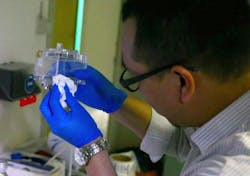Simple, low-cost solar cell improves hydrogen production from sunlight
IMAGE: TU Delft and the Helmholtz-Zentrum Berlin have developed a simpler solar cell concept that improves the production of hydrogen from sunlight. (Image credit: TU Delft)
Delft, The Netherlands--Published in the July online edition of Nature Communications, a research paper from Delft University of Technology (TU Delft) and the Helmholtz-Zentrum Berlin describes improved production of hydrogen from solar energy. Because breaking down water into hydrogen and oxygen using electricity in a hydrolysis process is expensive, the team looked to methods of using sunlight to split water into its component elements. Professor Bernard Dam of the Faculty of Applied Sciences at TU Delft explains that semiconducting electrodes are another solution: "Using relatively expensive solar cells, for instance, an efficiency of 4.7 per cent has been achieved. But we believe that that technique will be difficult to improve, and also that it will be a costly procedure. Our focus, therefore, has been a 'cheap and stable' solution."
This alternative solution for hydrogen production involves combining a simple, inexpensive solar cell with a photo anode: a light-sensitive material made from a metal oxide; bismuth vanadate (BiVO4), for example, which is stable in water. That was tried in earlier experiments, but the level of efficiency achieved was relatively low. The essential improvement now made by PhD student Fatwa Abdi is the addition of a so-called concentration gradient of tungsten atoms to the bismuth vanadate that dramatically improves the efficiency of the photo anode.
"In this way we have reached a yield of almost 5 per cent," says Dam. "In other words, nearly 5 per cent of the energy in the incident sunlight is stored in the hydrogen produced. For this type of set-up, that is a record. And we believe that an efficiency of 10 per cent can eventually be achieved."
"Moreover, this arrangement is stable and inexpensive. The bismuth vanadate is easy to spray, and it is a very cheap material used as a pigment in the paint industry. The solar cell we have been working with, of the amorphous silicon double-junction type, is also stable and inexpensive. In the future we should even be able to use the cheapest single-junction cell."
SOURCE: TU Delft; http://www.tudelft.nl/en/current/latest-news/article/detail/tu-delft-verbetert-productie-van-waterstof-uit-zonlicht/
